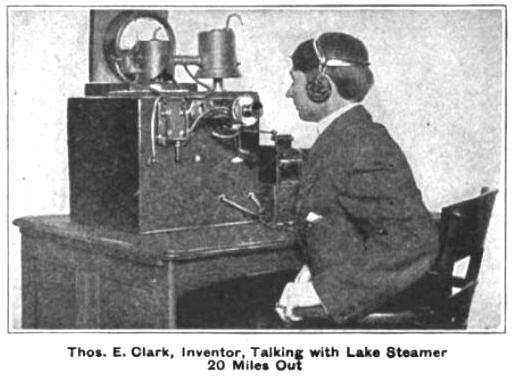Popular Mechanics, September, 1908, pages 635-636:

WIRELESS TELEPHONY OPERATING ON GREAT LAKES
 By the perfection of wireless telephone instruments in Detroit, Mich., this method of communication has been placed in practical commercial use on the Great Lakes, and every day since July 10, officers and passengers on the new steamer "City of Cleveland" have talked with the Detroit station from as far out as 25 miles. One of the illustrations is a facsimile of the placards placed in different parts of the big lake boat to notify passengers that they can communicate with friends on shore when desired. The boat is also equipped with wireless telegraph, but, as wireless telephony is the latest, it is quite natural that it should be the most in demand. The other illustration shows the inventor of the system at his desk in the Detroit station.
By the perfection of wireless telephone instruments in Detroit, Mich., this method of communication has been placed in practical commercial use on the Great Lakes, and every day since July 10, officers and passengers on the new steamer "City of Cleveland" have talked with the Detroit station from as far out as 25 miles. One of the illustrations is a facsimile of the placards placed in different parts of the big lake boat to notify passengers that they can communicate with friends on shore when desired. The boat is also equipped with wireless telegraph, but, as wireless telephony is the latest, it is quite natural that it should be the most in demand. The other illustration shows the inventor of the system at his desk in the Detroit station.
It is necessary with the Detroit system as now operated to talk and then listen, instead of being able to talk and listen at the same time, as in using the ordinary telephone. This is done by throwing over a listening key after talking and waiting for the response from the other end. The inventor, however, is working out a method which he believes will make it possible for the user to talk and listen simultaneously. He also claims that it will be possible to transmit speech or relay it from a local wire circuit to a wireless telephone circuit, thus enabling the officers of lake vessels to talk directly with the manager in the head office and passengers to communicate directly with their offices or homes. This, of course, when the vessels are within the wireless telephone zone.
The range of the wireless system depends upon the power used in transmission or the radiation of the waves. This will be increased, it is believed, until the entire area of the Great Lakes will be within the zone of some land station.
The working theory of wireless telephony is to provide means of radiating a stream of electrical waves sufficiently continuous to transmit the higher harmonics on which the quality of the voice depends, and also to provide means for the modifying of this stream of waves in accordance with the sound waves so that the continuously responsive receiver will give indications proportionate to the energy received and be capable of responding with sufficient rapidity to the speech harmonics. In the transmission of speech it is necessary to interrupt the continuous oscillation of high-frequency waves at intervals depending upon the character of the sound.
The great field of usefulness for the wireless telephone is, of course, for communicating from one vessel to another. The wireless telegraph apparatus is a great advantage in such communication, but the equipment requires an expert telegraph operator who understands the code, while anyone can use the wireless telephone.


 By the perfection of wireless telephone instruments in Detroit, Mich., this method of communication has been placed in practical commercial use on the Great Lakes, and every day since July 10, officers and passengers on the new steamer "City of Cleveland" have talked with the Detroit station from as far out as 25 miles. One of the illustrations is a facsimile of the placards placed in different parts of the big lake boat to notify passengers that they can communicate with friends on shore when desired. The boat is also equipped with wireless telegraph, but, as wireless telephony is the latest, it is quite natural that it should be the most in demand. The other illustration shows the inventor of the system at his desk in the Detroit station.
By the perfection of wireless telephone instruments in Detroit, Mich., this method of communication has been placed in practical commercial use on the Great Lakes, and every day since July 10, officers and passengers on the new steamer "City of Cleveland" have talked with the Detroit station from as far out as 25 miles. One of the illustrations is a facsimile of the placards placed in different parts of the big lake boat to notify passengers that they can communicate with friends on shore when desired. The boat is also equipped with wireless telegraph, but, as wireless telephony is the latest, it is quite natural that it should be the most in demand. The other illustration shows the inventor of the system at his desk in the Detroit station.